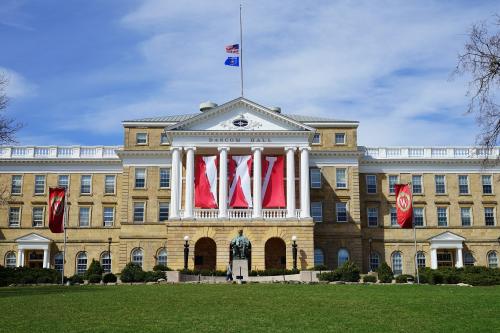In 1906, James McKeen Cattell of Columbia University assembled a list of the 1000 most eminent American scientists of his day and published an analysis of their geographic distribution in the journal Science, including the 40 cities with at least five top scientists. Those cities correspond to 30 metropolitan areas today. Those metropolitan areas were home to 26 percent of 1900 U.S. population but 78 percent of the nation’s top scientists. Today, these metropolitan areas account for 24 percent of the U.S. population and 42 percent of U.S. patents.
How important are research universities to the long-run prosperity of regions? What comes first, a thriving industrial sector or high quality institutions of science and research? Such questions are common in economic development work but painfully difficult to answer systematically.
Enrico Moretti’s provocative new book on the geography of prosperity grapples with such issues and states that research universities increase both the supply and demand for college graduates, but he criticizes efforts to create universities where there is no pre-existing ecosystem of industrial activity and research. The implication is that if you are mayor of El Paso, Modesto, Las Vegas, or Buffalo, you might as well give up on purposeful efforts. Success, in large part, comes down to luck and history. If you are fortunate enough to be Seattle, two local boys grow up to become Bill Gates and Paul Allen and eventually decide to locate their company, Microsoft, there.
Yet, for many metropolitan areas, a successful research institution preceded the development of a tech sector and probably played a very important role in its development. The metropolitan areas with star scientists in 1906 employed them in top-notch research institutions. The top ten metro areas, along with the institutions that employed the scientists include: New York (Columbia, NYU, City College), Washington DC (U.S. Geological Survey, Navy, Smithsonian Institution, and others), Boston (Harvard, MIT, and Tufts), Chicago (University of Chicago), Philadelphia (Penn, Bryn Mawr, Haverford), Baltimore (Johns Hopkins), New haven (Yale), Ithaca (Cornell), San Francisco (Berkeley), Ann Arbor (Michigan). Other metro areas with a prominent tech sector today made the list, such as San Jose (Stanford), Durham (UNC), Trenton (Princeton), and Minneapolis (University of Minnesota). In some of these places, it is hard to imagine any advantage that pre-dated the construction of the research institutions. For others, like Washington DC, New York, and Boston, other factors—like being the seat of government or having a prominent trading harbor—surely provided some additional benefit.
In any case, these endowments seem to have an advantageous legacy. Of the 30 metropolitan areas listed in 1906 as employing at least five of the 1000 top scientists in America, all 30, in 2010, score above the metropolitan average on either the share of workers with bachelors of science degrees or the share of workers in the tech sector. Indeed, all but three—Springfield, Massachusetts, Lawrence, Kansas, and Columbia, Missouri—score above average on both, all but three have above average median incomes, and all but 6 have an above average patenting rate; 22 have at least one top-ranked science program today, and all 30 offer graduate research programs in science. A strong research institute in the early 20th century almost guaranteed a strong regional economy in the early 21st century.
These results are consistent with research on “star” scientists. In a series of papers, Lynne Zucker and Michael Darby have found that highly specialized human capital—knowledge possessed by only a few expert academic researchers—played a huge role in the development of the U.S. biotech and nanotech sectors. This is why my colleagues at Brookings have recommended the lagging states like Nevada adopt state funded programs to recruit high-impact science scholars. As they pointed out, Georgia, Texas, Ohio, and Utah have already created these programs, with the latter’s USTAR program looking especially promising.
Yet, the absence of a strong research university in 1900 has not made it impossible to develop a strong tech sector by 2010. Places like Provo, Raleigh, Portland, Oregon, Salt Lake City, Denver, Rochester Minnesota, Los Angeles, San Diego, Dallas, Boise, and Bridgeport developed a strong tech sector subsequently. Some of this is probably attributable to the development of research institutions—like Cal Tech, UC San Diego, BYU, and the Mayo Clinic—though high tech companies have found it advantageous to start-up or locate in these places for a variety of reasons.
One lesson for struggling regions is: Don’t give up. A single top-notch research institution could invent ideas that transform an economy for generations. A critic could say: By definition, there are only a small number of star scientists to go around, so regional inequality is a given. While there is truth to that view in the short-run, it neglects the dynamism of innovation. In a supportive environment, stars reproduce through collaborations, training, and teaching. Moreover, economic growth generates demand, which both increases funding for R&D and makes its discoveries more valuable, leading to greater specialization and more stars. Meanwhile, high prices work as a countervailing force against regional inequality (e.g. high prices in San Jose and Boston have compelled tech companies to relocate to places like Portland, Boise, and Manchester-Nashua, New Hampshire).
In the meantime, just building a high quality research university seems to have a profound effect. That is the conclusion reached in a remarkable study of individual Finnish inventors by Otto Toivanen and Lotta Väänänen. On a variety of measures, Finland is the world’s most intensively inventive country. According to Toivanan and Väänänen’s calculations, the construction of three technical universities over the course of three decades increased the number of inventions in Finland by 20 percent from what it would have otherwise been. The reason, they argue, is that the location of these universities encouraged more people living near them to study engineering. It also increased the country’s capacity to educate more engineers.






Commentary
Top Research Institutions and Long-Run Regional Prosperity
September 24, 2012